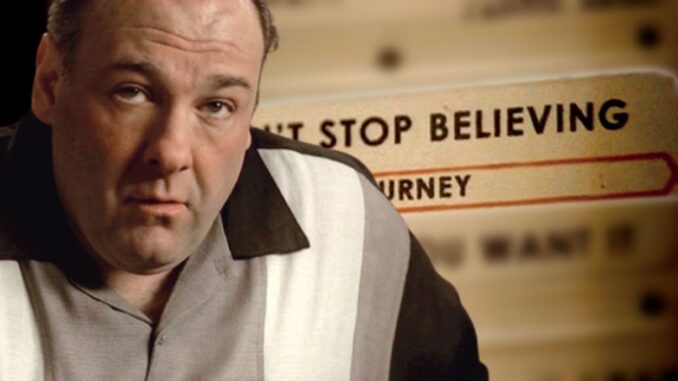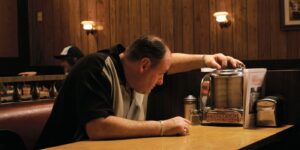
The final scene of The Sopranos sees Tony’s story suddenly cut to black, but not before Journey’s “Don’t Stop Believin'” plays out, a song choice with various meanings and possible interpretations in the context of the show’s ending. Widely (and rightly) regarded as one of the greatest TV shows of all time, The Sopranos went out with one of the most audacious and shocking finales in history, as the screen suddenly went dark, leaving many viewers wondering what had happened and whether or not their cable had cut out.
Even by The Sopranos’ own standards, it’s a scene ripe for analysis, and one that has been pored over and debated upon ever since, with various answers to questions such as whether or not Tony Soprano (the late James Gandolfini) actually died or not. Of course, while whether or not Tony died is a natural question to ask, it’s also not completely the point of those final moments. They instead tie into the larger themes of the show and of the dangers of the life Tony leads, and that’s in part supported by the decision to have Journey playing in the scene.
One of the key refrains in “Don’t Stop Believin'” is the line “It goes on and on, and on, and on,”, which is repeated several times throughout and feels particularly apt when discussing Tony’s life, and his final scene in particular. It doesn’t matter so much whether or not he dies there, perhaps whacked by the guy in the Member’s Only jacket, but rather that he will one day be killed. That he’s destined to spend the rest of his life looking at who is walking through the door ahead of him, or checking over his shoulder, because that’s the life he’s chosen and he has painted such a target on his back. In other words, even if he does live, what he’s experiencing in those final moments will go on and on, and on, and on.

Of course, it’s also possible to interpret the song as a message of hope for the viewers too, or at least those who want to think that Tony wasn’t killed. In that case, “Don’t Stop Believin'” takes on a more optimistic quality, allowing audiences to keep on believing that Tony survives. That, too, has a meaning both broader and deeper though, especially when applied to the show as a whole. The Sopranos is, at least in part, a dissection of the American Dream, and what that really entails. To not stop believing is a core tenet of said Dream, and so as the show ends – in an episode called “Made In America”, no less – then it’s one final comment on that, reflecting back upon what the entire run of The Sopranos has been about.
Chase himself has discussed the song choice in a breakdown of The Sopranos finale for the DGA, noting that a key reason for using it was the music, which he shot the scene too, allowing for all those necessary cuts between Tony and the door, and setting the tempo for a scene that, although it should be fairly nondescript (it is, after all, just a family eating at a diner) takes on a suspenseful, purposeful energy and quickening sense of dread. Of the decision to cut out just as the lyric “don’t stop” is sung, Chase adds: “The ceiling I was going for at that point, the biggest feeling I was going for, honestly, was don’t stop believing. It was very simple and much more on the nose than people think. That’s what I wanted people to believe. That life ends and death comes, but don’t stop believing.” Whether Tony died or not, it’s clear from the masterful final moments of The Sopranos, and its use of Journey’s “Don’t Stop Believin'”, that one day he will, but that viewers themselves will never give up believing either.
